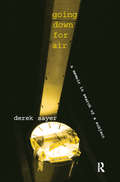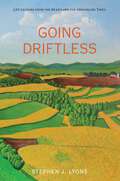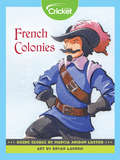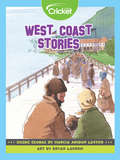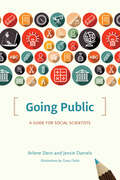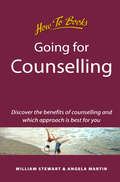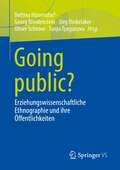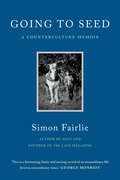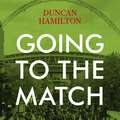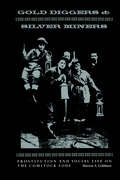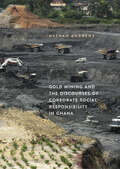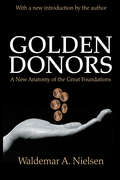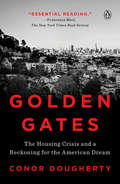- Table View
- List View
Going Abroad: Traveling Like an Anthropologist
by Rob GordonIncreasingly students from the affluent countries are going abroad as part of their "educational experience." Although students see these experiences as invaluable and believe that they have learned a lot, the anthropological literature suggests the opposite; that travel abroad has a greater impact on the hosts than on the visitors and that indeed travel abroad, far from leading to students becoming more open-minded or learning about the other, can reinforce their stereotypes. The standards in anthropology teach humility and the ability to learn from those in the host country. This short book can be read pre-departure and while abroad to provide the reader the practical and philosophical tools needed to create an enriched and mind-broadening experience.
Going All City: Struggle and Survival in LA's Graffiti Subculture
by Stefano BlochA graffiti writer’s memoir: “A brave portrait of a highly criticized subculture and a look inside the reality of growing up in low-income Los Angeles.” —LA Weekly“We could have been called a lot of things: brazen vandals, scared kids, threats to social order, self-obsessed egomaniacs, marginalized youth, outsider artists, trend setters, and thrill seekers. But, to me, we were just regular kids growing up hard in America and making the city our own. Being ‘writers’ gave us something to live for and ‘going all city’ gave us something to strive for; and for some of my friends it was something to die for.”In the age of commissioned wall murals and trendy street art, it’s easy to forget graffiti’s complicated and often violent past in the United States. Though graffiti has become one of the most influential art forms of the twenty-first century, cities nationwide waged a war against it from the late 1970s to the early 2000s, complete with brutal police task forces. Who were the vilified taggers they targeted? Teenagers, usually, from low-income neighborhoods with little to their names except a few spray cans and a desperate need to be seen—to mark their presence on city walls and buildings even as their cities turned a blind eye to them.Going All City is the mesmerizing and painful story of these young graffiti writers, told by one of their own. Prolific LA writer Stefano Bloch came of age in the late 1990s amid constant violence, poverty, and vulnerability. He recounts vicious interactions with police; debating whether to take friends with gunshot wounds to the hospital; coping with his mother’s heroin addiction; instability and homelessness; and his dread that his stepfather would get out of jail and tip his unstable life into full-blown chaos. But he also recalls moments of peace and exhilaration: marking a fresh tag; the thrill of running with his crew at night; exploring the secret landscape of LA; the dream and success of going all city.Bloch holds nothing back in this fierce, poignant memoir—an unflinching portrait of a deeply maligned subculture and an unforgettable account of what writing on city walls means to the most vulnerable people living within them.
Going Around: Selected Journalism
by Murray KemptonA definitive collection of writings by the legendary Pulitzer Prize-winning reporter Murray Kempton (1917-1997) with a foreword by Darryl Pinckney, gathering dozens of columns, essays, and critiques from publications including The New York Post, The New York Review of Books, The New Republic, and Newsday.With many uncollected and long out-of-print writings, this is the first volume of Kempton&’s work to appear in 30 years, a book that resdiscovers the legendary figure of journalism that David Remnick called &“the greatest newspaperman in town.&”&“The man is a marvel. It&’s like listening to Louis Armstrong, or Roy Eldridge: you don&’t know where the hell he is going, but somehow he gets there and it knocks your socks off.&” —Frank SinatraA courtly man of Southern roots, Murray Kempton worked as a labor reporter for the New York Post, won a Pulitzer Prize while at Newsday, and was arrested at the Democratic National Convention in Chicago along the way. He wore three piece suits and polished oxfords and was known for riding his bicycle around New York City while listening to his CD Walkman and smoking a pipe with wild red hair that later turned white. He developed a taste for baroque prose and became, in the words of Robert Silvers, his editor at The New York Review of Books, ''unmatched in his moral insight into the hypocrisies of politics and their consequences for the poor and powerless.''He went to court proceedings and traffic accidents and funerals and to speeches by people who either were or wanted to be rich and famous. He wrote about everything and anybody—Tonya Harding and Warren Harding, Fidel Castro and Mussolini, Harry Truman and Sal Maglie, St. Francis of Assisi and James Joyce and J. Edgar Hoover.From dispatches from a hardscrabble coal town in Western Maryland, a bus carrying Freedom Riders through Mississippi, an Iowa cornfield with Nikita Krushchev, an encampment of guerrillas in El Salvador, and Moscow at the end of the Soviet Union (these last two assignments filed by a reporter in his 70s), Kempton&’s concerns and interests were extraordinarily broad. He wrote about subjects from H.L. Mencken to Tupac Shakur; organized labor and McCarthyism; the Civil Rights and Black Power movements; presidential hopefuls and Mafiosi; frauds and failures of all stripes; the &“splendors and miseries&” of life in New York City.
Going Clear: Scientology, Hollywood, and the Prison of Belief
by Lawrence WrightA clear-sighted revelation, a deep penetration into the world of Scientology by the Pulitzer Prize-winning author of The Looming Tower, the now-classic study of al-Qaeda's 9/11 attack. Based on more than two hundred personal interviews with current and former Scientologists--both famous and less well known--and years of archival research, Lawrence Wright uses his extraordinary investigative ability to uncover for us the inner workings of the Church of Scientology.At the book's center, two men whom Wright brings vividly to life, showing how they have made Scientology what it is today: The darkly brilliant science-fiction writer L. Ron Hubbard, whose restless, expansive mind invented a new religion. And his successor, David Miscavige--tough and driven, with the unenviable task of preserving the church after the death of Hubbard.We learn about Scientology's complicated cosmology and special language. We see the ways in which the church pursues celebrities, such as Tom Cruise and John Travolta, and how such stars are used to advance the church's goals. And we meet the young idealists who have joined the Sea Org, the church's clergy, signing up with a billion-year contract.In Going Clear, Wright examines what fundamentally makes a religion a religion, and whether Scientology is, in fact, deserving of this constitutional protection. Employing all his exceptional journalistic skills of observation, understanding, and shaping a story into a compelling narrative, Lawrence Wright has given us an evenhanded yet keenly incisive book that reveals the very essence of what makes Scientology the institution it is.From the Hardcover edition.
Going Down for Air: A Memoir in Search of a Subject
by Charles C. Lemert Derek SayerWhat is hidden in the taste of a madeleine - or in snatches of Bob Dylan songs, operatic arias, and the remembered sting of a rattan cane? An exploration of memory, Going Down for Air artfully combines two very different yet connected texts. A Memoir is richly evocative not only of times past, but also of a very English, imperial, queerly masculine subjectivity, caught on the cusp of the extinction of the world in and of which it made sense. Derek Sayer's allusive writing succeeds as few have done before in capturing the leaps and bounds of memory itself. Rich in its detail, unstinting in its honesty, this beautifully written memoir is a considerable literary achievement. The memoir is complemented by Sayer's provocative theoretical essay on memory and social identity. Drawing on linguistic and psychoanalytic theory, photographic images, and literary texts, In Search of a Subject argues that it is memory above all that maintains the imagined identities upon which society rests. Going Down for Air is a bold and strikingly successful literary and sociological experiment, which makes a major contribution to understanding how our memories work - and gives them social meaning far beyond
Going Driftless: Life Lessons from the Heartland for Unraveling Times
by Stephen J. LyonsGoing Driftless is a book that explores a whole world within a world in the upper Midwest and looks at the nostalgia of small towns and local living (eating, shopping, etc.)—and asks how does it work what lessons can we learn from it.
Going Global: Borders, Naturally
by Marcia Amidon LustedCheck out these famous countries and regions that owe their shapes to an important geographic feature. These features help dictate so much about the countries they border.
Going Global: French Colonies
by Marcia Amidon LustedAn overview of how French Colonies have retained French traits. This article covers France's legacy in Cambodia, Canada, Laos, Morocco, and Vietnam.
Going Global: West Coast Stories
by Marcia Amidon LustedThe majority of immigrants who passed through Angel Island Immigration Station in the early 20th century came from China and Japan, but large groups also came from a few other nations.
Going Horizontal: Creating a Non-Hierarchical Organization, One Practice at a Time
by Samantha SladeHierarchy in organizations is obsolete. There is a better way: one that increases the engagement of employees and managers alike, reduces micromanaging and other limiting approaches, and promotes organizational and individual success. In this book, self-management expert Samantha Slade presents seven concrete practices to help your organization flatten its existing hierarchy and develop a horizontal organization. The result will be enhanced creativity, greater growth, and a increased employee retention and productivity—and a better bottom line.These days, more than ever, successful organizations must respond quickly and nimbly to change—they need every employee's best thinking. A horizontal organization creates an environment of true collaboration, respect, and openness. It allows everyone more freedom to express unconventional ideas or to work through issues that are getting in the way of organizational goals. And it's a more human way to organize—after all, we function perfectly well in our day-to day lives without someone telling us what to do. But when an organization decides to go horizontal, it can be overwhelming for both managers and employees. Slade offers a practical, proven, incremental method to help organizations of all kinds and sizes ease in to a non-hierarchical model. She includes techniques for using your organization's purpose to stay focused and aligned, developing shared decision-making, creating a mutual feedback culture, nurturing autonomy, holding co-managed meetings, and maintaining an environment of collective learning. Going Horizontal will help organizations become more adaptive, collaborative and innovative, which is vital in today's highly competitive and constantly-evolving world.
Going Public: A Guide for Social Scientists (Chicago Guides to Writing, Editing, and Publishing)
by Arlene Stein Corey Fields Jessie DanielsAt a time when policy discussions are dominated by “I feel” instead of “I know,” it is more important than ever for social scientists to make themselves heard. When those who possess in-depth training and expertise are excluded from public debates about pressing social issues—such as climate change, the prison system, or healthcare—vested interests can sway public opinion in uninformed ways. Yet few graduate students, researchers, or faculty know how to do this kind of work—or feel empowered to do it. While there has been an increasing call for social scientists to engage more broadly with the public, concrete advice for starting the conversation has been in short supply. Arlene Stein and Jessie Daniels seek to change this with Going Public, the first guide that truly explains how to be a public scholar. They offer guidance on writing beyond the academy, including how to get started with op-eds and articles and later how to write books that appeal to general audiences. They then turn to the digital realm with strategies for successfully building an online presence, cultivating an audience, and navigating the unique challenges of digital world. They also address some of the challenges facing those who go public, including the pervasive view that anything less than scholarly writing isn’t serious and the stigma that one’s work might be dubbed “journalistic.” Going Public shows that by connecting with experts, policymakers, journalists, and laypeople, social scientists can actually make their own work stronger. And by learning to effectively add their voices to the conversation, researchers can help make sure that their knowledge is truly heard above the digital din.
Going Public: How Silicon Valley Rebels Loosened Wall Street's Grip on the IPO and Sparked a Revolution
by Dakin CampbellA behind-the-scenes tour of the high-stakes world of IPOs and how a visionary band of startup executives, venture capitalists, and maverick bankers has launched a crusade to upend the traditional IPO as we know it.GOING PUBLIC is a character-driven narrative centered on the last five years of unparalleled change in how technology startups sell shares to the public. Initial public offerings, or IPOs, are typically the first time retail investors can own a piece of the New Economy companies promising to rewire economic rules. Selling IPOs is also one of the most profitable businesses for Wall Street investment banks, who have spent the last 40 years protecting their profits. In an era when algorithms and software have made the financial markets more efficient, the pricing of IPOs still relies on human judgment. In 2018, executives at music-streaming service Spotify sought to upend the status quo. Led by a trim and understated CFO, Barry McCarthy, and a shy but brilliant founder, Daniel Ek, they took a wild idea and forged something new. GOING PUBLIC explores how they got comfortable with the risk, and how they lobbied securities watchdogs and exchange staff to rewrite the regulations. Readers will meet executives at disruptive companies like Airbnb, DoorDash, venture capitalists, and even some bankers who seized on Spotify&’s labor and used it to knock Wall Street bankers off the piles of fees they&’d been stacking for so long. GOING PUBLIC weaves in earlier attempts to rethink the IPO process, introducing readers to one of Silicon Valley&’s earliest bankers, Bill Hambrecht, whose invention for selling shares online was embraced by Google founders Larry Page and Sergey Brin when they auctioned their shares in 2004. And it examines the recent boom in blank-check companies, those Wall Street insider deals that have suddenly become the hottest way to enter the public markets. GOING PUBLIC tells stories from inside the room, and more.
Going Remote: How the Flexible Work Economy Can Improve Our Lives and Our Cities
by Matthew E. KahnA leading urban economist's hopeful study of how shifts to remote work can change all of our lives for the better. As COVID-19 descended upon the country in 2020, millions of American office workers transitioned to working from home to reduce risk of infection and prevent spread of the virus. In the aftermath of this shift, a significant number of workers remain at least partially remote. It is clear that this massive experiment we were forced to run will have long-term consequences, changing the shape of our personal and work lives, as well as the urban landscape around us. How will the rise of telecommuting affect workers' quality of life, the profitability of firms, and the economic geography of our cities and suburbs? Going Remote addresses the uncertainties and possibilities of this moment. In Going Remote, urban economist Matthew E. Kahn takes readers on a journey through the new remote-work economy, revealing how people will configure their lives when they have more freedom to choose where they work and how they live. Melding ideas from labor economics, family economics, the theory of the firm, and urban economics, Kahn paints a realistic picture of the future for workers, firms, and urban areas, big and small. As Kahn shows, the rise of remote work presents especially valuable opportunities for flexibility and equity in the lives of women, minorities, and young people, and even for those whose jobs do not allow them to work from home. Uncovering key implications for our quality of life, Going Remote demonstrates how the rise of remote work can significantly improve the standard of living for millions of people by expanding personal freedom, changing the arc of how we live, work, and play.
Going Solo
by Eric KlinenbergGoing Solo is an examination of the most significant demographic shift since the Baby Boom - the sharp increase in the number of people who live alone.
Going Solo: Single Mothers by Choice (Routledge Library Editions: Family)
by Jean RenvoizeOriginally published in 1985, this, at the time, controversial book explores the fundamental changes in personal relationships that had taken place over the previous decade, focusing on women who had deliberately chosen to have children outside a permanent relationship. After travelling widely throughout Britain, the United States and Holland meeting those personally involved, Jean Renvoize discusses why a growing number of women were deciding to become single mothers. She discovers the implications of this for the future of the family and for old-style love and commitment between the sexes. She analyses the position both of the children of these single families and of their mothers. She looks at men’s feelings about being used a ‘stud’ and uncovers the desire of some men to have a family without being financially and emotionally involved with a long-term partner. Importantly, Jean Renvoize places the new style of personal relationship in the context of the advance of the women’s movement. It is clear that ordinary and non-political women’s and men’s lives have been more fundamentally changed by feminism than they may realise. But few of the mothers interviewed by the author are actively feminist: lesbians apart, they all have in common past relationships with men, and would happily settle with the right man could their high expectations be met. Without exception, all those who made the deliberate choice to ‘go solo’ have loving, joyful and rewarding experiences of motherhood. Having a child alone has been fraught with problems for all, but those who have met the challenge have found such great fulfilment that one is faced with an inevitable question: are a woman and her child better off without a man? When so many marriages end in divorce, is a stable unit of two better than a broken unit of three? But also, might those without the motivation of successful ‘solo mothers’ rush thoughtlessly into motherhood – and find themselves exhausted, broke and very unhappy? Presenting in their own words the experiences of those directly involved, this was above all a practical book. It provided welcome and necessary insights into the changing pattern of relationships at the time – for the married and unmarried; for parents and non-parents. Today it can be read and enjoyed in its historical context.
Going for Counselling: Working with your counsellor to develop awareness and essential life skills
by William StewartThis book explores the counselling process and will help you to choose a counsellor to suit your needs. Counselling isn't always problem centred. It can enable you to develop self-awareness and introduce you to ways in which you can manage your life more effectively. This book will show you how.
Going public?: Erziehungswissenschaftliche Ethnographie und ihre Öffentlichkeiten
by Georg Breidenstein Tanya Tyagunova Jörg Dinkelaker Bettina Hünersdorf Oliver SchnoorDer Band dokumentiert die facettenreiche Diskussion des Verhältnisses von erziehungswissenschaftlicher Ethnographie zu ihren Öffentlichkeiten in gegenstandstheoretischer, methodologischer und politischer Hinsicht. Die Beiträge befassen sich mit der Frage, ob und warum sich erziehungswissenschaftliche Ethnographie welche Öffentlichkeiten erschließt bzw. erschließen sollte und welche Effekte jeweils davon für diese bzw. für (sozial-)pädagogische Handlungsfelder und ihre Adressat*innen ausgehen.
Going to Seed: A Counterculture Memoir
by Simon FairlieAn unforgettable firsthand account of how the hippie movement flowered in the late 1960s, appeared spent by the Thatcher-consumed 1980s, yet became the seedbed for progressive reform we now take for granted—and continues to inspire generations of rebels and visionaries. "Fairlie has a refreshingly declarative style: he’s analytical, funny and self-aware. . . His memoir has much to offer anyone interested in movement history or in the future of intentional communities."—Elizabeth Royte, Food & Environment Reporting Network At a young age, Simon Fairlie rejected the rat race and embarked on a new trip to find his own path. He dropped out of Cambridge University to hitchhike to Istanbul and bicycle through India. He established a commune in France, was arrested multiple times for squatting and civil disobedience, and became a leading figure in protests against the British government’s road building programs of the 1980s and—later—in legislative battles to help people secure access to land for low impact, sustainable living. Over the course of fifty years, we witness a man’s drive for self-sufficiency, freedom, authenticity, and a deep connection to the land. Fairlie grew up in a middle-class household in leafy middle England. His path had been laid out for him by his father: boarding school, Oxbridge, and a career in journalism. But everything changed when Simon’s life ran headfirst into London’s counterculture in the 1960s. Finding Beat poetry, blues music, cannabis and anti–Vietnam War protests unlocked a powerful lust to be free. Instead of becoming a celebrated Fleet Street journalist like his father, Simon became a laborer, a stonemason, a farmer, a scythesman, and then a magazine editor and a writer of a very different sort. In Going to Seed he shares the highs of his experience, alongside the painful costs of his ongoing search for freedom—estrangement from his family, financial insecurity, and the loss of friends and lovers to the excesses and turbulence that continued through the 70s and 80s. Part moving, free-wheeling memoir, part social critique, Going to Seed questions the current trajectory of Western “progress”—and the explosive consumerism, growing inequality, and environmental devastation laid bare in our daily newsfeeds—and will resonate with anyone who wonders how we got to such a place. Simon’s story is for anyone who wonders what the world might look like if we began to chart a radically different course.
Going to the Match: The Passion for Football
by Duncan HamiltonA massive audience in sitting-rooms, parks and pubs watched England in the 2018 World Cup. Yet as Duncan Hamilton demonstrates with style, insight and wit in Going to the Match, watching on TV is no substitute for being there. Hamilton embarks on a richly entertaining, exquisitely crafted journey through football. Glory game or grass roots, England v Slovenia or Guiseley v Hartlepool, he delves beneath the action to illuminate the stories which make the sport endlessly compelling.Along the way he marvels at present-day titans Harry Kane, Mo Salah, Kevin De Bruyne and Paul Pogba, reflects on sepia-tinted magicians Stanley Matthews, Jimmy Greaves, Bobby Charlton and Pele, and assesses managerial giants from Brian Clough and Jose Mourinho to Arsene Wenger and Gareth Southgate.The odyssey takes Hamilton from Fleetwood to Berlin, via Glasgow and a Manchester derby, making detours into art, cinema, literature and politics as he explores the game's ever-changing culture and character.The result, like the L.S. Lowry painting that inspired the book, is a football masterpiece.
Going to the Match: The Perfect Gift for Football Fans
by Duncan HamiltonA massive audience in sitting-rooms, parks and pubs watched England in the 2018 World Cup. Yet as Duncan Hamilton demonstrates with style, insight and wit in Going to the Match, watching on TV is no substitute for being there. Hamilton embarks on a richly entertaining, exquisitely crafted journey through football. Glory game or grass roots, England v Slovenia or Guiseley v Hartlepool, he delves beneath the action to illuminate the stories which make the sport endlessly compelling.Along the way he marvels at present-day titans Harry Kane, Mo Salah, Kevin De Bruyne and Paul Pogba, reflects on sepia-tinted magicians Stanley Matthews, Jimmy Greaves, Bobby Charlton and Pele, and assesses managerial giants from Brian Clough and Jose Mourinho to Arsene Wenger and Gareth Southgate.The odyssey takes Hamilton from Fleetwood to Berlin, via Glasgow and a Manchester derby, making detours into art, cinema, literature and politics as he explores the game's ever-changing culture and character.The result, like the L.S. Lowry painting that inspired the book, is a football masterpiece.
Going to the Match: The Perfect Gift for Football Fans
by Duncan HamiltonA celebration of football by award-winning sports writer, Duncan Hamilton.A massive audience in sitting-rooms, parks and pubs watched England in the 2018 World Cup. Yet as Duncan Hamilton demonstrates with style, insight and wit in Going to the Match, watching on TV is no substitute for being there. Hamilton embarks on a richly entertaining, exquisitely crafted journey through football. Glory game or grass roots, England v Slovenia or Guiseley v Hartlepool, he delves beneath the action to illuminate the stories which make the sport endlessly compelling.Along the way he marvels at present-day titans Harry Kane, Mo Salah, Kevin De Bruyne and Paul Pogba, reflects on sepia-tinted magicians Stanley Matthews, Jimmy Greaves, Bobby Charlton and Pele, and assesses managerial giants from Brian Clough and Jose Mourinho to Arsene Wenger and Gareth Southgate.The odyssey takes Hamilton from Fleetwood to Berlin, via Glasgow and a Manchester derby, making detours into art, cinema, literature and politics as he explores the game's ever-changing culture and character.The result, like the L.S. Lowry painting that inspired the book, is a football masterpiece.(P)2018 Hodder & Stoughton Limited
Gold Diggers and Silver Miners: Prostitution and Social Life on the Comstock Lode (Women And Culture Series)
by Marion S. GoldmanIn 1859 high grade silver bullion was discovered on the Comstock Lode. In a twinkling, Virginia City was transformed into a brawling boom town perched on a mountain of silver. Twenty years later it virtually disappeared, leaving behind played-out mines, tumbled-down shanties, and memories of those who sought their fortunes on the lode. The fortune seekers were many: miners and madams, confidence men and dance hall girls. The fast life was as stratified as any proper community, ranging from expensively kept women to prostitutes living in cribs. Laura Fair, an elite member of the demimonde, shot her protector and, after a spectacular trial, retired to live modestly in San Francisco. Jessie Lester made a small fortune as a madam while middle rank prostitutes such as Julia Bulette died in debt. At the lowest end of scale were "celestial damsels," nameless slave women brought from China to minister to the needs of Chinese workers. Chronicling it all was the cynical and lascivious pen of Alf Doten, writer, editor, and bon vivant. In Gold Diggers and Silver Miners, sociologist Marion S. Goldman provides a detailed account of prostitution on the Comstock Lode. By considering sexual commerce in a community limited in space and time, she explores general relationships between prostitution and society, shedding light on sociological questions of importance today.
Gold Mining and the Discourses of Corporate Social Responsibility in Ghana
by Nathan AndrewsThis book critically examines the practice and meanings of corporate social responsibility (CSR) and how the movement has facilitated a positive and somewhat unquestioned image of the global corporation. Drawing on extensive fieldwork material collected in Ghanaian communities located around the project sites of Newmont Mining Corporation and Kinross Gold Corporation, the monograph employs critical discourse analysis to accentuate how mining corporations use CSR as a discursive alibi to gain legitimacy and dominance over the social order, while determining their own spheres of responsibility and accountability. Hiding behind such notions as ‘social licence to operate’ and ‘best practice,’ corporations are enacted as entities that are morally conscious and socially responsible. Yet, this enactment is contested in host communities, as explored in chapters that examine corporate citizenship, gendered perspectives, and how global CSR norms institutionalize unaccountability.
Golden Donors: A New Anatomy of the Great Foundations
by Waldemar A. NielsenThe world of the golden donors - the rich and influential philanthropic foundations - is quite likely the least known and yet most pervasive of all the invisible money and power networks in America. Nielsen explores the 36 largest of the 22,000 currently active foundations. He takes the reader inside each of the giants to analyze its people, policies, and performance. From the most famous, Ford and MacArthur, to the most obscure, Mabee and Moody, the author lets in daylight and lets out the bats as well as the butterflies. Golden Donors is a journey through 36 flefdoms, each of which controls upwards of $250 million dollars, beyond the reach of the IRS, in order to encourage medical research, support cultural and artistic endeavors, and not least, to buttress immensely expensive educational institutions. Which of the great foundations in recent years have been spectacular successes and which are failures? Is today's leadership in the third-stream economy equal to the task? Are foundations, seedbeds or killing grounds of new social and political ideas? And what is the federal government, and a variety of administrations, doing to help or harm this new economy? Nielsen provides many surprising and some quite startling answers for the millions of Americans whose lives the golden donors directly or indirectly affect. When Golden Donors first appeared, A. Bartlett Giamatti praised it as an historical guide, a shrewd critique, and an impassioned warning. "This remarkable book on the nation's largest foundations must be ready by anyone concerned with America's unique not-for-profit sector and the quality of our national life." Kingman Brewster saw the book as "a revealing mirror held up to the faces of big philanthropy...a must book for foundation creators and leaders." Thornton F. Bradsahw said, "Golden Donors describes the large American foundations, what they are how they got that way, and wherein lies their strength and their potential. The book is wise, witty, and perceptive - indispensable reading."
Golden Gates: Fighting for Housing in America
by Conor DoughertyA stunning, deeply reported investigation into the housing crisis Spacious and affordable homes used to be the hallmark of American prosperity. Today, however, punishing rents and the increasingly prohibitive cost of ownership have turned housing into the foremost symbol of inequality and an economy gone wrong. Nowhere is this more visible than in the San Francisco Bay Area, where fleets of private buses ferry software engineers past the tarp-and-plywood shanties where the homeless make their homes. The adage that California is a glimpse of the nation's future has become a cautionary tale.With propulsive storytelling and ground-level reporting, New York Times journalist Conor Dougherty chronicles America's housing crisis from its West Coast epicenter, peeling back the decades of history and economic forces that brought us here and taking readers inside the activist uprisings that have risen in tandem with housing costs. To tell this new story of housing, Dougherty follows a struggling math teacher who builds a political movement dedicated to ending single-family-house neighborhoods. A teenaged girl who leads her apartment complex against their rent-raising landlord. A nun who tries to outmaneuver private equity investors by amassing a multimillion-dollar portfolio of affordable homes. A suburban bureaucrat who roguishly embraces density in response to the threat of climate change. A developer who manufactures homeless housing on an assembly line.Sweeping in scope and intimate in detail, Golden Gates captures a vast political realignment during a moment of rapid technological and social change.




